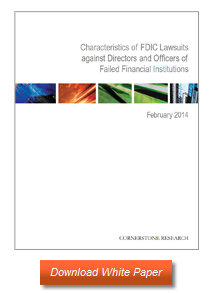
FDIC D&O Lawsuits Surge in 2013
Brought to you by Cornerstone Research

 Federal Deposit Insurance Corporation (FDIC) litigation activity associated with failed financial institutions increased significantly in 2013. The FDIC filed 40 director and officer (D&O) lawsuits in 2013, compared with 26 in 2012, a 54 percent increase from 2012. The pace of new lawsuits in 2013 slowed in the fourth quarter to only three, however, compared with 10, 15, and 12 in the preceding quarters.
Federal Deposit Insurance Corporation (FDIC) litigation activity associated with failed financial institutions increased significantly in 2013. The FDIC filed 40 director and officer (D&O) lawsuits in 2013, compared with 26 in 2012, a 54 percent increase from 2012. The pace of new lawsuits in 2013 slowed in the fourth quarter to only three, however, compared with 10, 15, and 12 in the preceding quarters.
These findings are included in “Characteristics of FDIC Lawsuits against Directors and Officers of Failed Financial Institutions—February 2014,” a Cornerstone Research report.
Analysis
The surge in FDIC D&O lawsuits in 2013 stems from the high number of financial institution failures in 2009 and 2010. Of the 140 financial institutions that failed in 2009, the directors and officers of 64 (or 46 percent) have either been the subject of an FDIC lawsuit or have settled claims with the FDIC prior to the filing of a lawsuit. For the 157 institutions that failed in 2010, 53 (or 34 percent) have either been the subject of a lawsuit or have settled with the FDIC.
The FDIC’s D&O lawsuits in 2013 particularly focused on the largest institutions that failed in 2010. Of the largest 20 failures in 2010, 15, or 75 percent, have already been subject to FDIC lawsuits or settled claims with the FDIC.
Claimed Damages
From the beginning of 2010 to the end of 2013, the FDIC has filed 84 D&O lawsuits. It has explicitly stated damages amounts in 77 of the 84 complaints against directors and officers of failed financial institutions, for a total of at least $3.8 billion in claimed damages. While nearly half of the 84 lawsuits were filed in 2013, only $1.2 billion, or 32 percent of the FDIC’s claimed damages, is attributable to the lawsuits filed in 2013. This pattern mirrors the relatively smaller size of the institutions that that were the subject of 2013 D&O lawsuits.
Defendants and Charges
Inside and outside directors, together, have also routinely been named as defendants in FDIC D&O lawsuits. This pattern continued in 2013 (75 percent of lawsuits filed in 2013). Outside directors were exclusively named as defendants in rare instances and only in lawsuits filed in 2013 (8 percent). Somewhat more common were lawsuits in which only inside directors were named (15 percent of 2013 lawsuits, compared with 23 percent of lawsuits filed before 2013).
Chief executive officers continue to be the most commonly named officers in FDIC D&O lawsuits. The FDIC named CEOs in 83 percent of the complaints filed in 2013. In contrast, chief credit officers, chief loan officers, chief operating officers, or chief banking officers were named in 43 percent of the 2013 lawsuits.
All 40 lawsuits filed in 2013 included allegations of gross negligence, and 32 included additional allegations of negligence. Thirty-five of the 40 lawsuits included allegations of breach of fiduciary duty.
Settlements
Of the FDIC’s 84 D&O lawsuits, at least 17 have settled in whole or in part and one has resulted in a jury verdict. The FDIC has also settled disputes with directors and officers prior to the filing of a complaint. Settlement agreements published by the FDIC indicate that in at least 82 instances, the agency has resolved disputes with directors and officers. In these settlements, as many as 38 agreements, or 46 percent, required payments by the directors and officers. Directors and officers agreed to pay at least $34 million in these cases.
Future Trends
While the FDIC’s filings of new D&O lawsuits hit a lull in the fourth quarter of 2013, new filings are unlikely to continue at such a slow pace in the first half of 2014. Three lawsuits have already been filed in January, and as motions and discovery unfold in existing lawsuits, this year will be interesting to follow. For example, a recent ruling in the U.S. Court of Appeals for the Eleventh Judicial Circuit pertinent to the many Georgia-based lawsuits allows directors and officers to assert defenses related to the FDIC’s post-receivership conduct that will directly affect loss causation and damages arguments. These types of judicial rulings may greatly influence the relative negotiating strength of the FDIC and defendants. How this ruling and others like it affect the likelihood of settlements may determine whether we see protracted litigation in the FDIC’s D&O lawsuits or movement to settle cases earlier.

